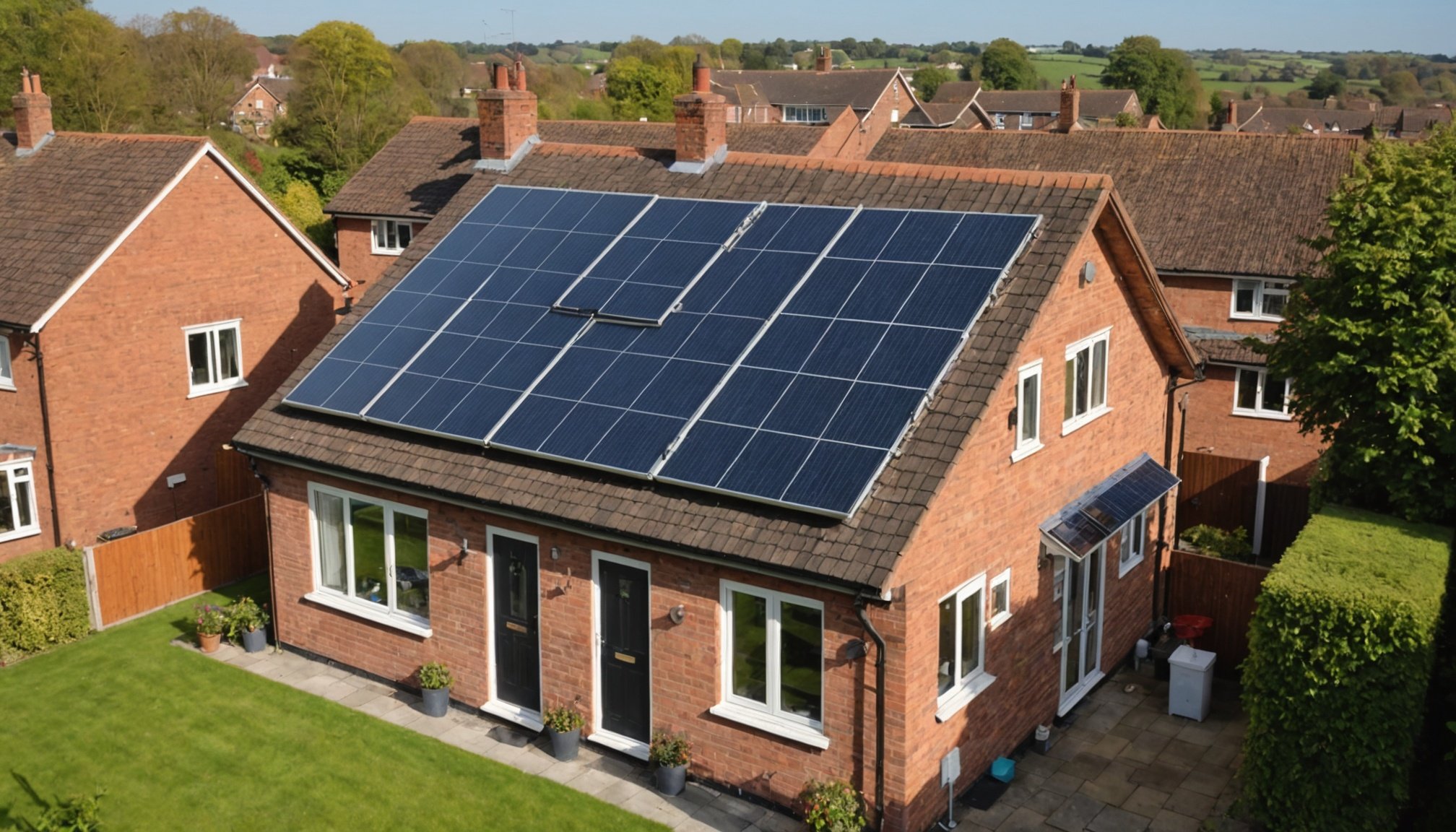Unlocking Hot Water Savings: Optimize Your UK Semi-Detached Home with Solar Thermal Solutions
Understanding Solar Thermal Systems
When it comes to reducing your energy bills and carbon footprint, solar thermal systems are often overlooked in favor of solar PV panels. However, for homes in the UK, especially semi-detached houses, solar thermal systems can be a highly effective way to save on hot water heating costs.
How Solar Thermal Systems Work
Solar thermal systems use solar panels to heat water, which is then stored in a tank for use in your home. These systems are designed to capture the sun’s energy and convert it into heat, rather than electricity. Here’s a breakdown of how they work:
Also to discover : Eco-friendly garage transformation: innovative sustainable design tips for uk homeowners
- Solar Collectors: These are the panels installed on your roof that absorb the sun’s energy.
- Heat Transfer: The absorbed energy is transferred to a fluid, which is then pumped through a heat exchanger.
- Hot Water Storage: The heated fluid warms up the water in your storage tank, providing you with hot water for your home.
Savings on Hot Water Bills
One of the most significant benefits of solar thermal systems is the savings they can offer on your hot water bills. According to the Energy Saving Trust, these systems can save you around 50% on the cost of your hot water[1].
- Annual Savings: For an average household with a gas boiler, this translates to about £110 per year. For homes with an electric boiler, the savings can be even higher, up to £200 per year.
- Long-Term Benefits: Over the 20-30 year lifespan of a solar thermal system, these savings can add up significantly, although the initial investment might not be fully recouped due to the high upfront cost.
Suitability for UK Homes
Despite the varying UK weather, solar thermal systems can still be highly effective, especially when properly sized and installed.
Also to see : Your ultimate guide to choosing sustainable timber for outdoor decking in rural uk homes
Weather Considerations
- Seasonal Variations: While solar thermal systems perform best during the summer months, they can still provide about 25% of your hot water needs during the colder winter months[1].
- Roof Requirements: For optimal performance, your roof should have minimal shading, an angle of around 40 degrees, and face south, east, or west. Fortunately, most UK homes have pitched roofs that meet these criteria[1].
Compatibility with Other Systems
Solar thermal systems can be integrated with other renewable energy solutions to enhance their efficiency.
- Heat Pumps: Combining solar thermal with heat pumps can provide a comprehensive low-carbon heating solution.
- Battery Storage: While not directly compatible with battery storage, using solar thermal alongside solar PV and battery storage can create a highly efficient and renewable energy system for your home.
Installation and Maintenance
Installing and maintaining a solar thermal system requires careful consideration to ensure it operates efficiently.
Installation Costs and Process
- Initial Investment: The cost of a solar thermal system can range from £6,000, depending on the type and size of the system[1].
- Installation Process: The installation involves placing the solar collectors on your roof, connecting them to the heat exchanger, and ensuring the system is properly integrated with your existing heating setup. It is crucial to use MCS accredited installation companies to ensure the job is done correctly.
Maintenance and Lifespan
- Lifespan: Solar thermal systems typically last around 20 years but can last up to 30 years with proper maintenance[1].
- Warranties: Most warranties for these systems are for 10 years, which is shorter than those for solar PV panels but still provides a good level of protection for your investment.
Comparing Solar Thermal to Solar PV
While solar thermal systems are excellent for hot water heating, it’s important to compare them with solar PV systems to understand which might be more beneficial for your home.
Savings and Efficiency
- Solar PV Savings: Solar PV systems can cut your electricity bills by up to 103% and earn you money through export tariffs, potentially saving you £800-£900 per year[1].
- Solar Thermal Savings: As mentioned earlier, solar thermal systems save around 50% on hot water costs, but the savings are generally lower than those from solar PV.
Lifespan and Maintenance
- Solar PV Lifespan: Solar PV panels typically last between 30 to 40 years, with warranties often lasting 25 years or more[1].
- Solar Thermal Lifespan: Solar thermal systems have a shorter lifespan and warranty period compared to solar PV.
| System Type | Savings | Lifespan | Warranty | Initial Cost |
|---|---|---|---|---|
| Solar Thermal | 50% on hot water | 20-30 years | 10 years | £6,000 |
| Solar PV | Up to 103% on electricity | 30-40 years | 25 years+ | £6,000 – £8,000 |
Financial Incentives and Government Support
There are various financial incentives and government support schemes that can make installing solar thermal or solar PV systems more affordable.
Government Grants and Schemes
- Boiler Upgrade Scheme: This scheme provides funding for low-carbon heating systems, including solar thermal and heat pumps[4].
- Smart Export Guarantee (SEG): For solar PV systems, this scheme allows homeowners to earn money by selling excess electricity back to the grid[2].
Mandatory Solar Panels on New Builds
There is a growing push for making solar panels mandatory on new build homes in the UK. This initiative aims to reduce carbon emissions and cut energy bills for homeowners.
- Future Homes Standard: This standard, set to take effect in 2025, aims to improve the energy efficiency of new homes by incorporating clean technologies like solar panels and heat pumps[3].
Practical Insights and Actionable Advice
If you’re considering installing a solar thermal system or any other renewable energy solution, here are some practical insights and actionable advice:
Assess Your Roof
- Shading and Orientation: Ensure your roof has minimal shading and faces the right direction (south, east, or west) for optimal performance[2].
- Roof Condition: Make sure your roof is in good condition and can support the weight of the solar collectors.
Choose the Right Installer
- MCS Accreditation: Always use MCS accredited installation companies to ensure the installation is done correctly and meets the necessary standards[2].
Consider Combining Technologies
- Solar PV and Battery Storage: Combining solar thermal with solar PV and battery storage can create a highly efficient and renewable energy system for your home[1].
Quotes and Expert Opinions
Here are some quotes and expert opinions that highlight the benefits and challenges of solar thermal and other renewable energy solutions:
-
Jamie Brookes, Director of Green Funding Solutions, E.ON:
“Innovative and more affordable finance options are key to inspiring homeowners to make their homes sustainable and to help wean the country off our dependence on fossil fuels. By offering flexible payment options and enabling people to spread upfront costs when updating their homes, we hope to remove the finance barrier and make low carbon options more accessible by encouraging more homeowners to take the greener choice.”[4] -
Simon Roberts, co-founder and CEO of Heatio:
“Our research shows us that one of the main barriers to installing technology like heat pumps and solar panels is the upfront cost. That’s why we’ve created a solution which incorporates Hometree Finance’s monthly payment plan with zero to minimal upfront costs so that households can install the technology in their homes, feel more in control and start saving money.”[4]
Solar thermal systems offer a viable solution for reducing hot water heating costs in UK homes, particularly semi-detached houses. While they may not offer the same level of savings as solar PV systems, they are a valuable addition to any home looking to reduce its carbon footprint and energy bills.
By understanding how these systems work, their suitability for UK weather, and the financial incentives available, you can make an informed decision about whether a solar thermal system is right for your home.
Key Takeaways
- Energy Efficiency: Solar thermal systems can save you around 50% on your hot water costs.
- Lifespan and Maintenance: These systems last around 20-30 years and require regular maintenance.
- Financial Incentives: Government schemes and grants can make the initial investment more affordable.
- Combining Technologies: Integrating solar thermal with other renewable energy solutions can enhance efficiency.
In the pursuit of a more sustainable and energy-efficient home, considering solar thermal solutions is a step in the right direction towards achieving your net zero goals.

